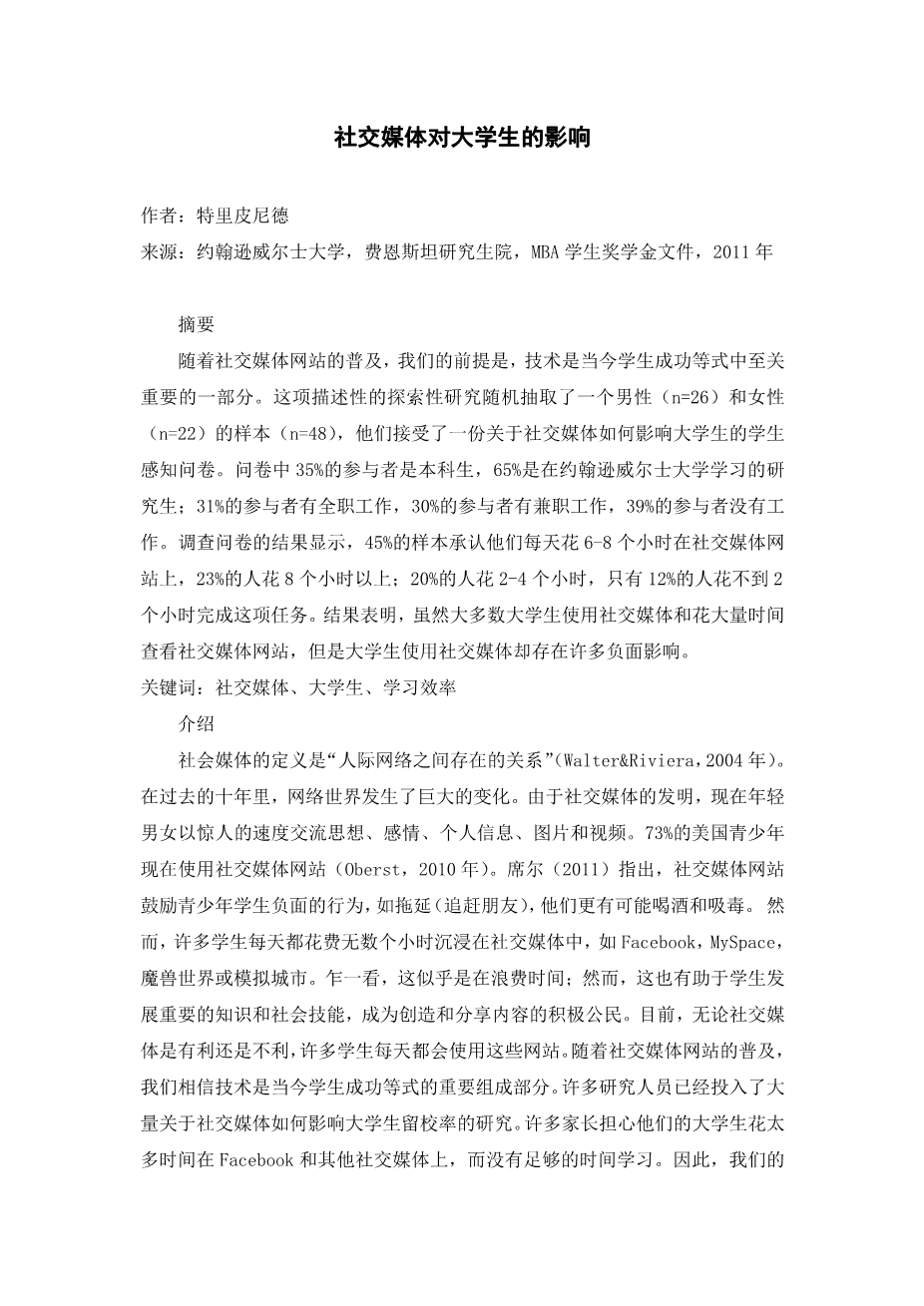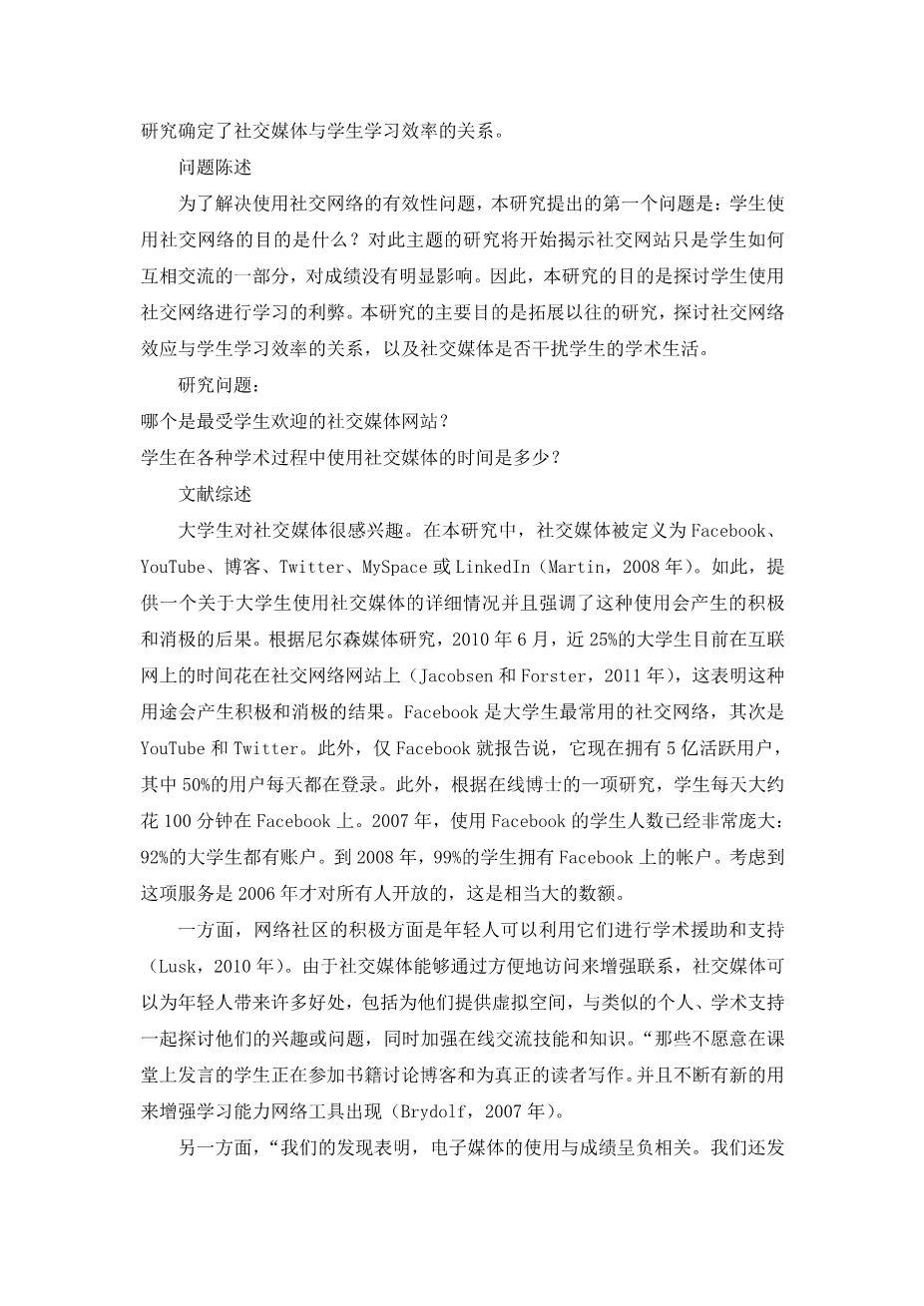The Effects of Social Media on College Students
作者:Terri Pinyerd
来源:Johnson amp;Wales University, Feinstein Graduate School, RSCH5500-Research amp; Analysis, 2011
Abstract
As social media sites continue to grow in popularity, it is our premise that technology is a vital part in today’s student success equation. This descriptive, exploratory research study drew a random sample (N=48) of males (n=26) and females (n=22) who were administered a student perception questionnaire on how social media affects college students. Thirty-five percent of the participants were undergraduates and 65% were graduate students, studying at Johnson amp; Wales University. Thirty-one percent of participants have full-time jobs, 30% have part-time jobs and 39% do not have jobs. The results of the survey questionnaire indicate that 45% of the sample admitted that they spent 6-8 hours per day checking social media sites, while 23% spent more than 8 hours; 20% spent 2-4 hours and only 12% spent less than 2 hours on this task. Results indicate while most college students use social media and spend many hours checking social media sites, there was a negative aspect to college students’ use of social media.
Key Words: social media, college students, learning efficiency
Introduction
The definition of social media is “the relationships that exist between network of
people” (Walter amp; Riviera, 2004). In the last ten years, the online world has changed dramatically. Thanks to the invention of social media, young men and women now exchange ideas, feelings, personal information, pictures and videos at a truly astonishing rate. Seventy-three percent of wired American teens now use social media websites (Oberst, 2010). Schill (2011) states that the social media sites encourage negative behaviors for teen students such as procrastination (catching up with friends), and they are more likely to drink and drug. However, every day, many students are spending countless hours immersed in social media, such as Facebook, MySpace, World of Warcraft, or Sim City. At first glance this may seem like a waste of time; however it also helps students to develop important knowledge and social skills, and be active citizens who create and share content. At present, whether social media is favorable or unfavorable, many students utilize these sites on a daily basis. As social media sites continue to grow in popularity it is our belief that technology is a vital part of today’s student success equation. Many researchers have been diving into a considerable amount of research on how social media influences student retention at colleges. Many parents are worried that their college students are spending too much time on Facebook and other social media sites and not enough time studying. Therefore, our research ascertains the relationship between the social media and students’ study efficiency.
Statement of Problem
To address the issue of the effectiveness of using social networking, the first question raised in this study is: for what purpose is the student utilizing social networking? Research on this topic will start to reveal social networking sites are simply part of how students interact with each other with no apparent impact on grades. Thus, the objective of this research is to explore the advantages and disadvantages of students’ use of social networking for study. The main purpose of this research is to expand on previous research, explore the relationship between the effects of social networking and students’ study efficiency, and to determine if social media interfering with students’ academic lives.
Research Questions:
Which is the most popular social media site for students? What is the amount of time students spend utilizing social media in various academic processes?
Review of the Literature
College students have great interest in social media. For the purpose of this study, social media was defined as Facebook, YouTube, Blogs, Twitter, MySpace or LinkedIn (Martin, 2008). Although, providing a detailed perspective on social media use among university students and underscoring that such use can produce both positive and negative consequences, according to a Nielsen Media Research study, in June 2010, almost 25 percent of students’ time on the Internet is now spent on social networking websites (Jacobsen, amp; Forste, 2011). Facebook is the most used social network by college students, followed by YouTube and Twitter. Moreover, Facebook alone reports that it now has 500 active million users, 50% of whom log on every day.
In addition, according to a study by Online PhD, students spend roughly 100 minutes per day on Facebook. In 2007, the number of students who used Facebook was already enormous: 92 percent of college students had an account. By 2008, 99 percent of students had an account on Facebook. That is quite a large amount considering the service was only opened in 2006 to everyone.
On one hand, the positive aspect of online communities is that youths can utilize them for academic assistance and support (Lusk, 2010). Due to the ability of social media to enhance connections by making them easily accessible, social media can yield many benefits for the young, including providing a virtual space for them to explore their interests or problems with similar individuals, academic support, while strengthening online communication skills and knowledge. “Students who may be reluctant to speak up in class are participating in book discussion blogs and writing for real audiences. There are new Web tools emerging all the time that are enhancing learning (Brydolf, 2007).”
On the other hand, “Our findings indicate that electronic media use is negatively associated with grades. We also find that about two-thirds of the students re
剩余内容已隐藏,支付完成后下载完整资料


英语译文共 6 页,剩余内容已隐藏,支付完成后下载完整资料
资料编号:[438665],资料为PDF文档或Word文档,PDF文档可免费转换为Word
以上是毕业论文外文翻译,课题毕业论文、任务书、文献综述、开题报告、程序设计、图纸设计等资料可联系客服协助查找。


